Corporate Finance Report
VerifiedAdded on 2020/01/16
|17
|4707
|646
Report
AI Summary
This report examines Rolls Royce Holdings plc's dividend policy and foreign exchange risk management. Part A analyzes dividend policy theories (Walter's model, Gordon's model, Modigliani-Miller hypothesis) and reviews Rolls Royce's dividend payments and share price performance over five years. It concludes by recommending an optimal dividend policy balancing shareholder expectations and company growth. Part B identifies three types of foreign exchange risk (transaction, translation, economic) and discusses their relative importance for Rolls Royce. Four internal hedging strategies (local currency denomination, leads and lags, netting, currency matching) and two external hedging techniques (forward and money market hedges) are critically evaluated and assessed for their relevance to Rolls Royce's operations in the defense industry. The report uses financial data and relevant theories to support its analysis and recommendations.
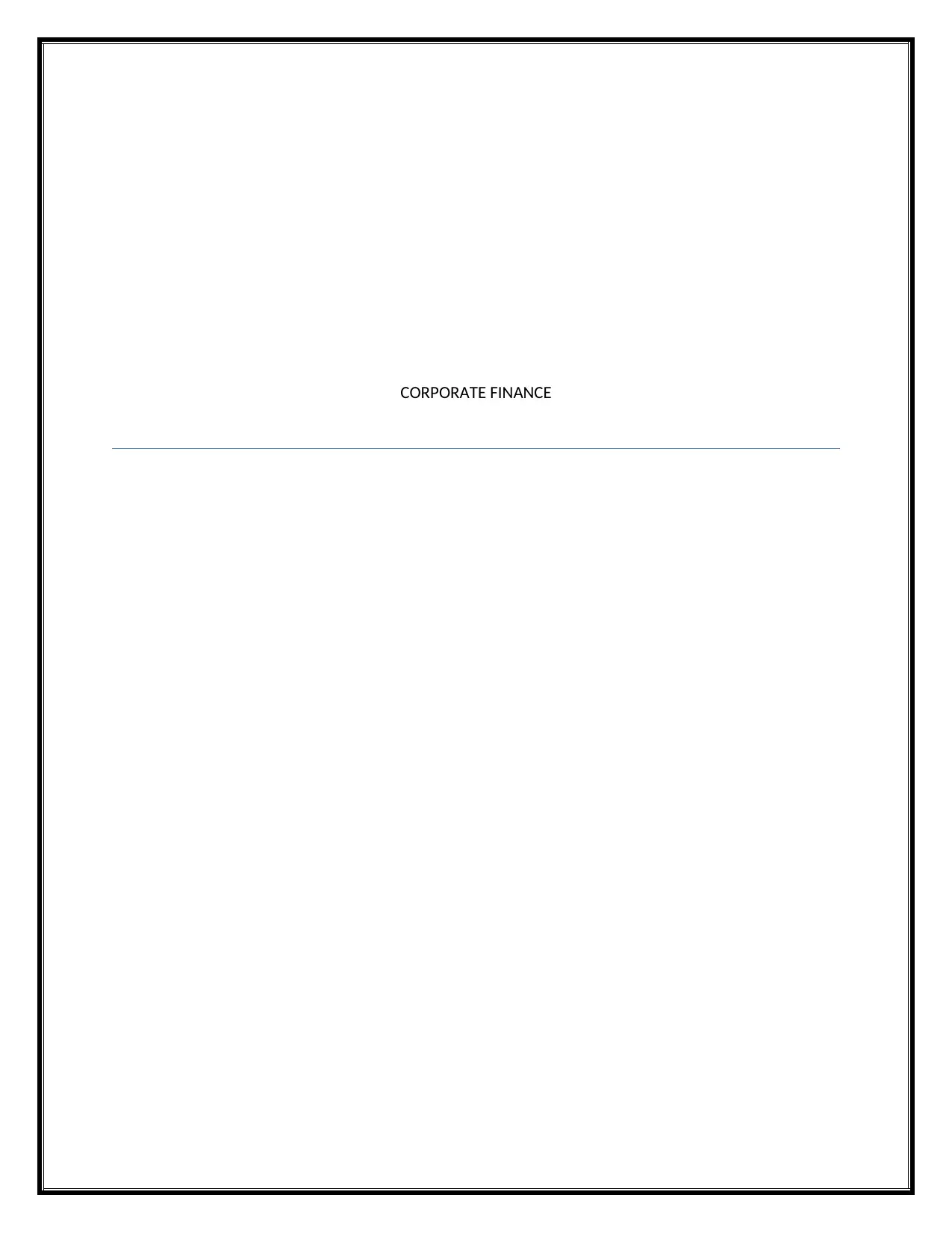
CORPORATE FINANCE
Paraphrase This Document
Need a fresh take? Get an instant paraphrase of this document with our AI Paraphraser
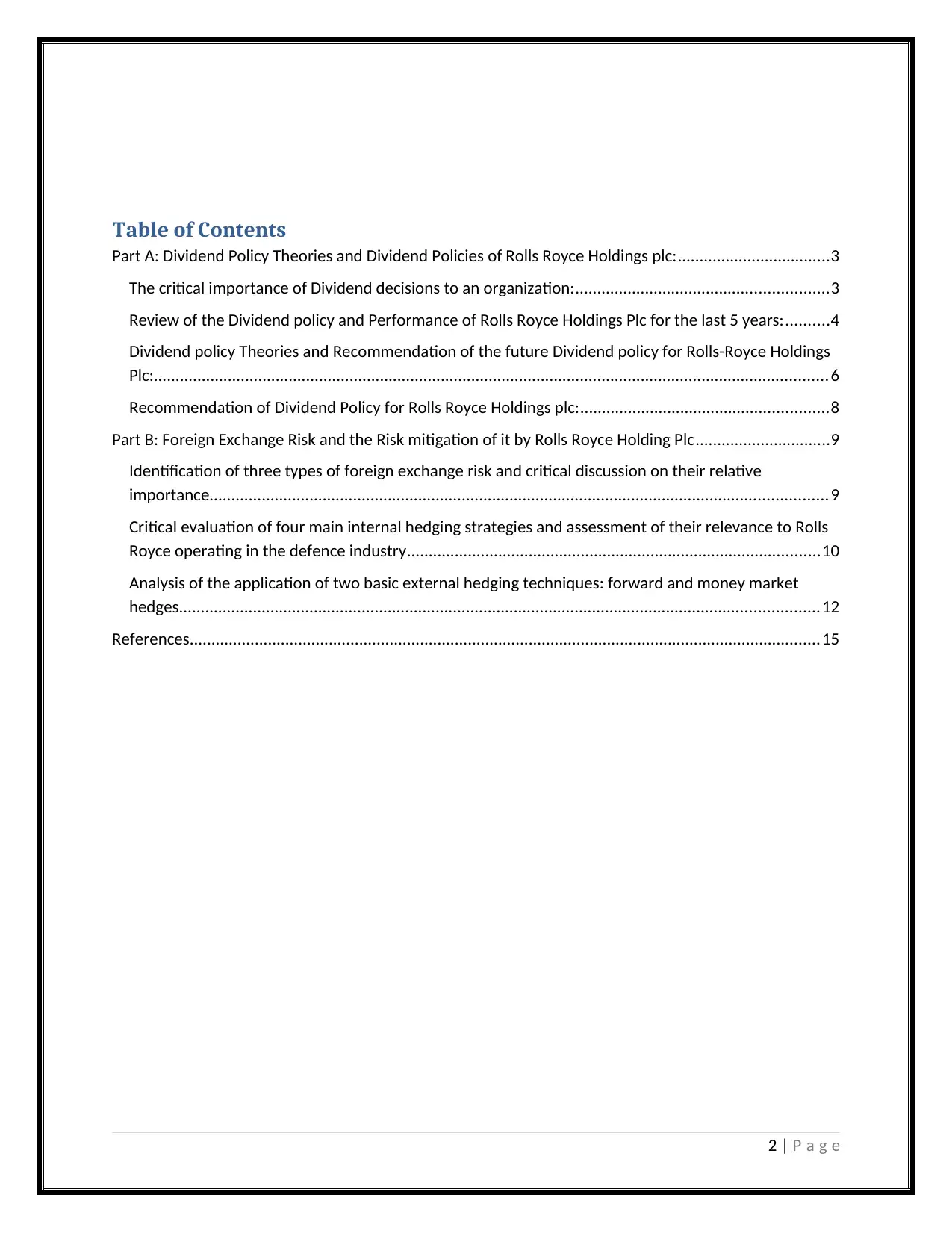
Table of Contents
Part A: Dividend Policy Theories and Dividend Policies of Rolls Royce Holdings plc:...................................3
The critical importance of Dividend decisions to an organization:..........................................................3
Review of the Dividend policy and Performance of Rolls Royce Holdings Plc for the last 5 years:..........4
Dividend policy Theories and Recommendation of the future Dividend policy for Rolls-Royce Holdings
Plc:...........................................................................................................................................................6
Recommendation of Dividend Policy for Rolls Royce Holdings plc:.........................................................8
Part B: Foreign Exchange Risk and the Risk mitigation of it by Rolls Royce Holding Plc...............................9
Identification of three types of foreign exchange risk and critical discussion on their relative
importance..............................................................................................................................................9
Critical evaluation of four main internal hedging strategies and assessment of their relevance to Rolls
Royce operating in the defence industry...............................................................................................10
Analysis of the application of two basic external hedging techniques: forward and money market
hedges...................................................................................................................................................12
References.................................................................................................................................................15
2 | P a g e
Part A: Dividend Policy Theories and Dividend Policies of Rolls Royce Holdings plc:...................................3
The critical importance of Dividend decisions to an organization:..........................................................3
Review of the Dividend policy and Performance of Rolls Royce Holdings Plc for the last 5 years:..........4
Dividend policy Theories and Recommendation of the future Dividend policy for Rolls-Royce Holdings
Plc:...........................................................................................................................................................6
Recommendation of Dividend Policy for Rolls Royce Holdings plc:.........................................................8
Part B: Foreign Exchange Risk and the Risk mitigation of it by Rolls Royce Holding Plc...............................9
Identification of three types of foreign exchange risk and critical discussion on their relative
importance..............................................................................................................................................9
Critical evaluation of four main internal hedging strategies and assessment of their relevance to Rolls
Royce operating in the defence industry...............................................................................................10
Analysis of the application of two basic external hedging techniques: forward and money market
hedges...................................................................................................................................................12
References.................................................................................................................................................15
2 | P a g e
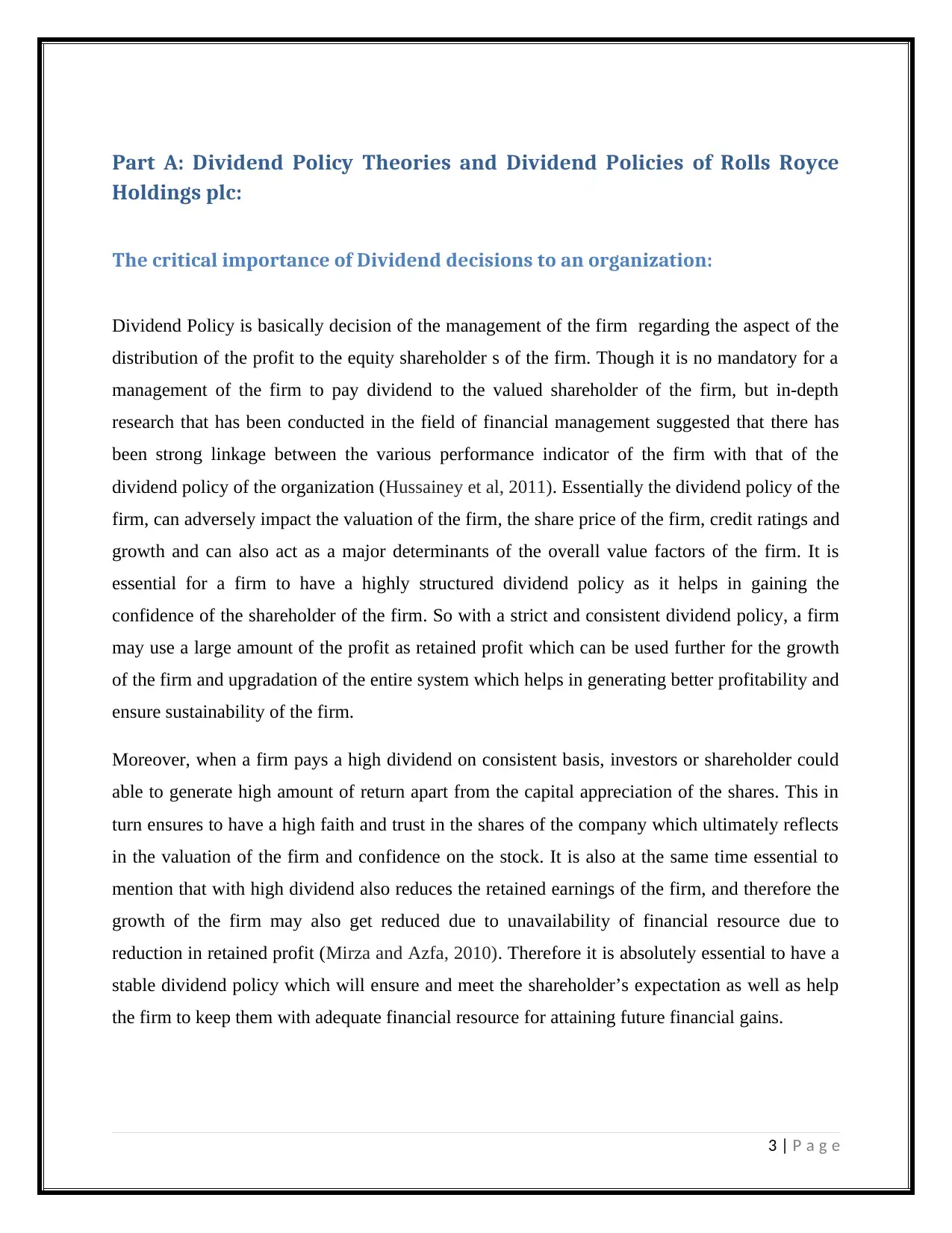
Part A: Dividend Policy Theories and Dividend Policies of Rolls Royce
Holdings plc:
The critical importance of Dividend decisions to an organization:
Dividend Policy is basically decision of the management of the firm regarding the aspect of the
distribution of the profit to the equity shareholder s of the firm. Though it is no mandatory for a
management of the firm to pay dividend to the valued shareholder of the firm, but in-depth
research that has been conducted in the field of financial management suggested that there has
been strong linkage between the various performance indicator of the firm with that of the
dividend policy of the organization (Hussainey et al, 2011). Essentially the dividend policy of the
firm, can adversely impact the valuation of the firm, the share price of the firm, credit ratings and
growth and can also act as a major determinants of the overall value factors of the firm. It is
essential for a firm to have a highly structured dividend policy as it helps in gaining the
confidence of the shareholder of the firm. So with a strict and consistent dividend policy, a firm
may use a large amount of the profit as retained profit which can be used further for the growth
of the firm and upgradation of the entire system which helps in generating better profitability and
ensure sustainability of the firm.
Moreover, when a firm pays a high dividend on consistent basis, investors or shareholder could
able to generate high amount of return apart from the capital appreciation of the shares. This in
turn ensures to have a high faith and trust in the shares of the company which ultimately reflects
in the valuation of the firm and confidence on the stock. It is also at the same time essential to
mention that with high dividend also reduces the retained earnings of the firm, and therefore the
growth of the firm may also get reduced due to unavailability of financial resource due to
reduction in retained profit (Mirza and Azfa, 2010). Therefore it is absolutely essential to have a
stable dividend policy which will ensure and meet the shareholder’s expectation as well as help
the firm to keep them with adequate financial resource for attaining future financial gains.
3 | P a g e
Holdings plc:
The critical importance of Dividend decisions to an organization:
Dividend Policy is basically decision of the management of the firm regarding the aspect of the
distribution of the profit to the equity shareholder s of the firm. Though it is no mandatory for a
management of the firm to pay dividend to the valued shareholder of the firm, but in-depth
research that has been conducted in the field of financial management suggested that there has
been strong linkage between the various performance indicator of the firm with that of the
dividend policy of the organization (Hussainey et al, 2011). Essentially the dividend policy of the
firm, can adversely impact the valuation of the firm, the share price of the firm, credit ratings and
growth and can also act as a major determinants of the overall value factors of the firm. It is
essential for a firm to have a highly structured dividend policy as it helps in gaining the
confidence of the shareholder of the firm. So with a strict and consistent dividend policy, a firm
may use a large amount of the profit as retained profit which can be used further for the growth
of the firm and upgradation of the entire system which helps in generating better profitability and
ensure sustainability of the firm.
Moreover, when a firm pays a high dividend on consistent basis, investors or shareholder could
able to generate high amount of return apart from the capital appreciation of the shares. This in
turn ensures to have a high faith and trust in the shares of the company which ultimately reflects
in the valuation of the firm and confidence on the stock. It is also at the same time essential to
mention that with high dividend also reduces the retained earnings of the firm, and therefore the
growth of the firm may also get reduced due to unavailability of financial resource due to
reduction in retained profit (Mirza and Azfa, 2010). Therefore it is absolutely essential to have a
stable dividend policy which will ensure and meet the shareholder’s expectation as well as help
the firm to keep them with adequate financial resource for attaining future financial gains.
3 | P a g e
⊘ This is a preview!⊘
Do you want full access?
Subscribe today to unlock all pages.

Trusted by 1+ million students worldwide
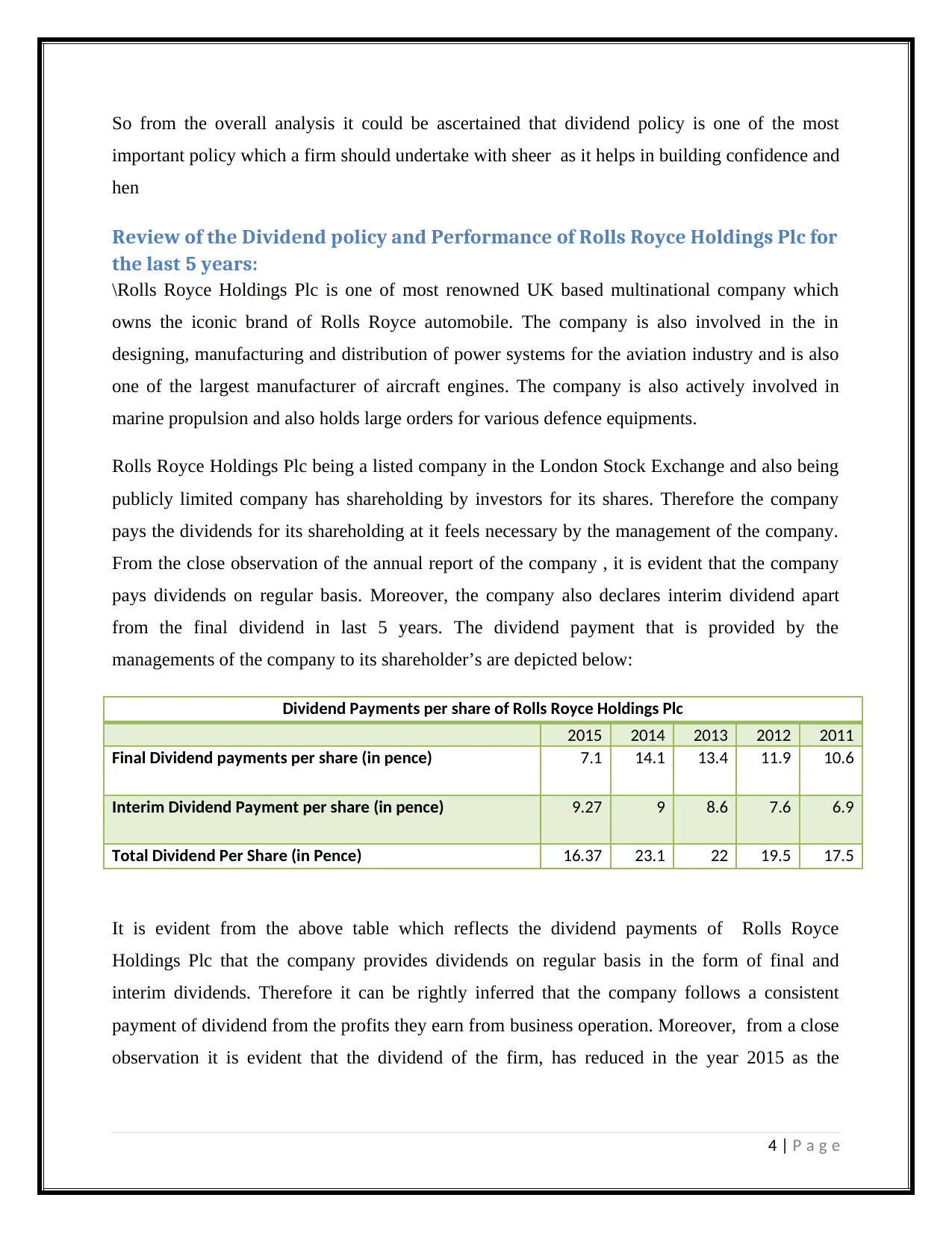
So from the overall analysis it could be ascertained that dividend policy is one of the most
important policy which a firm should undertake with sheer as it helps in building confidence and
hen
Review of the Dividend policy and Performance of Rolls Royce Holdings Plc for
the last 5 years:
\Rolls Royce Holdings Plc is one of most renowned UK based multinational company which
owns the iconic brand of Rolls Royce automobile. The company is also involved in the in
designing, manufacturing and distribution of power systems for the aviation industry and is also
one of the largest manufacturer of aircraft engines. The company is also actively involved in
marine propulsion and also holds large orders for various defence equipments.
Rolls Royce Holdings Plc being a listed company in the London Stock Exchange and also being
publicly limited company has shareholding by investors for its shares. Therefore the company
pays the dividends for its shareholding at it feels necessary by the management of the company.
From the close observation of the annual report of the company , it is evident that the company
pays dividends on regular basis. Moreover, the company also declares interim dividend apart
from the final dividend in last 5 years. The dividend payment that is provided by the
managements of the company to its shareholder’s are depicted below:
Dividend Payments per share of Rolls Royce Holdings Plc
2015 2014 2013 2012 2011
Final Dividend payments per share (in pence) 7.1 14.1 13.4 11.9 10.6
Interim Dividend Payment per share (in pence) 9.27 9 8.6 7.6 6.9
Total Dividend Per Share (in Pence) 16.37 23.1 22 19.5 17.5
It is evident from the above table which reflects the dividend payments of Rolls Royce
Holdings Plc that the company provides dividends on regular basis in the form of final and
interim dividends. Therefore it can be rightly inferred that the company follows a consistent
payment of dividend from the profits they earn from business operation. Moreover, from a close
observation it is evident that the dividend of the firm, has reduced in the year 2015 as the
4 | P a g e
important policy which a firm should undertake with sheer as it helps in building confidence and
hen
Review of the Dividend policy and Performance of Rolls Royce Holdings Plc for
the last 5 years:
\Rolls Royce Holdings Plc is one of most renowned UK based multinational company which
owns the iconic brand of Rolls Royce automobile. The company is also involved in the in
designing, manufacturing and distribution of power systems for the aviation industry and is also
one of the largest manufacturer of aircraft engines. The company is also actively involved in
marine propulsion and also holds large orders for various defence equipments.
Rolls Royce Holdings Plc being a listed company in the London Stock Exchange and also being
publicly limited company has shareholding by investors for its shares. Therefore the company
pays the dividends for its shareholding at it feels necessary by the management of the company.
From the close observation of the annual report of the company , it is evident that the company
pays dividends on regular basis. Moreover, the company also declares interim dividend apart
from the final dividend in last 5 years. The dividend payment that is provided by the
managements of the company to its shareholder’s are depicted below:
Dividend Payments per share of Rolls Royce Holdings Plc
2015 2014 2013 2012 2011
Final Dividend payments per share (in pence) 7.1 14.1 13.4 11.9 10.6
Interim Dividend Payment per share (in pence) 9.27 9 8.6 7.6 6.9
Total Dividend Per Share (in Pence) 16.37 23.1 22 19.5 17.5
It is evident from the above table which reflects the dividend payments of Rolls Royce
Holdings Plc that the company provides dividends on regular basis in the form of final and
interim dividends. Therefore it can be rightly inferred that the company follows a consistent
payment of dividend from the profits they earn from business operation. Moreover, from a close
observation it is evident that the dividend of the firm, has reduced in the year 2015 as the
4 | P a g e
Paraphrase This Document
Need a fresh take? Get an instant paraphrase of this document with our AI Paraphraser

company has in total provided lower dividend of only 16. 37 pence as compared to previous 4
year.
Review of Performance of Rolls Royce Holdings Plc:
The review of share price of Rolls Royce Holdings Plc from February 2012 to December 2016 is
depicted below:
It can be observed that the valuation of share or the price of the shares has decreased in absolute
terms considering the period of February 2012 to December 2016. Though the share price
escalated and there was rising trends in 2013 and 2015 but from the year 2015 the share price of
the company has witnessed a declining trend. In absolute terms the share price of the stock has
decreased from £820 in February 2012 to £668 in December 2016. So it is absolutely evident the
share price of the firm has declines which has impacted on the overall valuation of the firm.
5 | P a g e
year.
Review of Performance of Rolls Royce Holdings Plc:
The review of share price of Rolls Royce Holdings Plc from February 2012 to December 2016 is
depicted below:
It can be observed that the valuation of share or the price of the shares has decreased in absolute
terms considering the period of February 2012 to December 2016. Though the share price
escalated and there was rising trends in 2013 and 2015 but from the year 2015 the share price of
the company has witnessed a declining trend. In absolute terms the share price of the stock has
decreased from £820 in February 2012 to £668 in December 2016. So it is absolutely evident the
share price of the firm has declines which has impacted on the overall valuation of the firm.
5 | P a g e
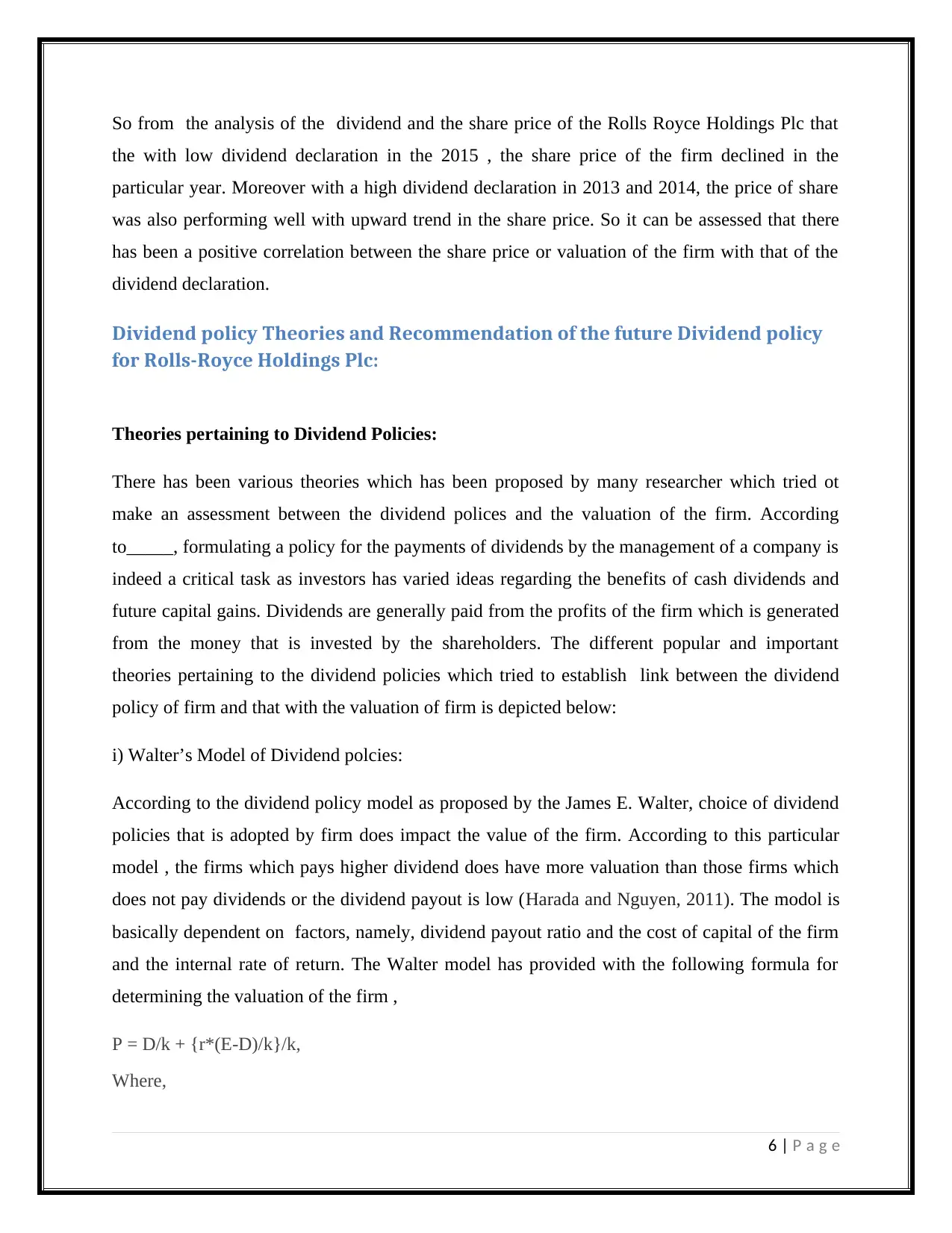
So from the analysis of the dividend and the share price of the Rolls Royce Holdings Plc that
the with low dividend declaration in the 2015 , the share price of the firm declined in the
particular year. Moreover with a high dividend declaration in 2013 and 2014, the price of share
was also performing well with upward trend in the share price. So it can be assessed that there
has been a positive correlation between the share price or valuation of the firm with that of the
dividend declaration.
Dividend policy Theories and Recommendation of the future Dividend policy
for Rolls-Royce Holdings Plc:
Theories pertaining to Dividend Policies:
There has been various theories which has been proposed by many researcher which tried ot
make an assessment between the dividend polices and the valuation of the firm. According
to_____, formulating a policy for the payments of dividends by the management of a company is
indeed a critical task as investors has varied ideas regarding the benefits of cash dividends and
future capital gains. Dividends are generally paid from the profits of the firm which is generated
from the money that is invested by the shareholders. The different popular and important
theories pertaining to the dividend policies which tried to establish link between the dividend
policy of firm and that with the valuation of firm is depicted below:
i) Walter’s Model of Dividend polcies:
According to the dividend policy model as proposed by the James E. Walter, choice of dividend
policies that is adopted by firm does impact the value of the firm. According to this particular
model , the firms which pays higher dividend does have more valuation than those firms which
does not pay dividends or the dividend payout is low (Harada and Nguyen, 2011). The modol is
basically dependent on factors, namely, dividend payout ratio and the cost of capital of the firm
and the internal rate of return. The Walter model has provided with the following formula for
determining the valuation of the firm ,
P = D/k + {r*(E-D)/k}/k,
Where,
6 | P a g e
the with low dividend declaration in the 2015 , the share price of the firm declined in the
particular year. Moreover with a high dividend declaration in 2013 and 2014, the price of share
was also performing well with upward trend in the share price. So it can be assessed that there
has been a positive correlation between the share price or valuation of the firm with that of the
dividend declaration.
Dividend policy Theories and Recommendation of the future Dividend policy
for Rolls-Royce Holdings Plc:
Theories pertaining to Dividend Policies:
There has been various theories which has been proposed by many researcher which tried ot
make an assessment between the dividend polices and the valuation of the firm. According
to_____, formulating a policy for the payments of dividends by the management of a company is
indeed a critical task as investors has varied ideas regarding the benefits of cash dividends and
future capital gains. Dividends are generally paid from the profits of the firm which is generated
from the money that is invested by the shareholders. The different popular and important
theories pertaining to the dividend policies which tried to establish link between the dividend
policy of firm and that with the valuation of firm is depicted below:
i) Walter’s Model of Dividend polcies:
According to the dividend policy model as proposed by the James E. Walter, choice of dividend
policies that is adopted by firm does impact the value of the firm. According to this particular
model , the firms which pays higher dividend does have more valuation than those firms which
does not pay dividends or the dividend payout is low (Harada and Nguyen, 2011). The modol is
basically dependent on factors, namely, dividend payout ratio and the cost of capital of the firm
and the internal rate of return. The Walter model has provided with the following formula for
determining the valuation of the firm ,
P = D/k + {r*(E-D)/k}/k,
Where,
6 | P a g e
⊘ This is a preview!⊘
Do you want full access?
Subscribe today to unlock all pages.

Trusted by 1+ million students worldwide
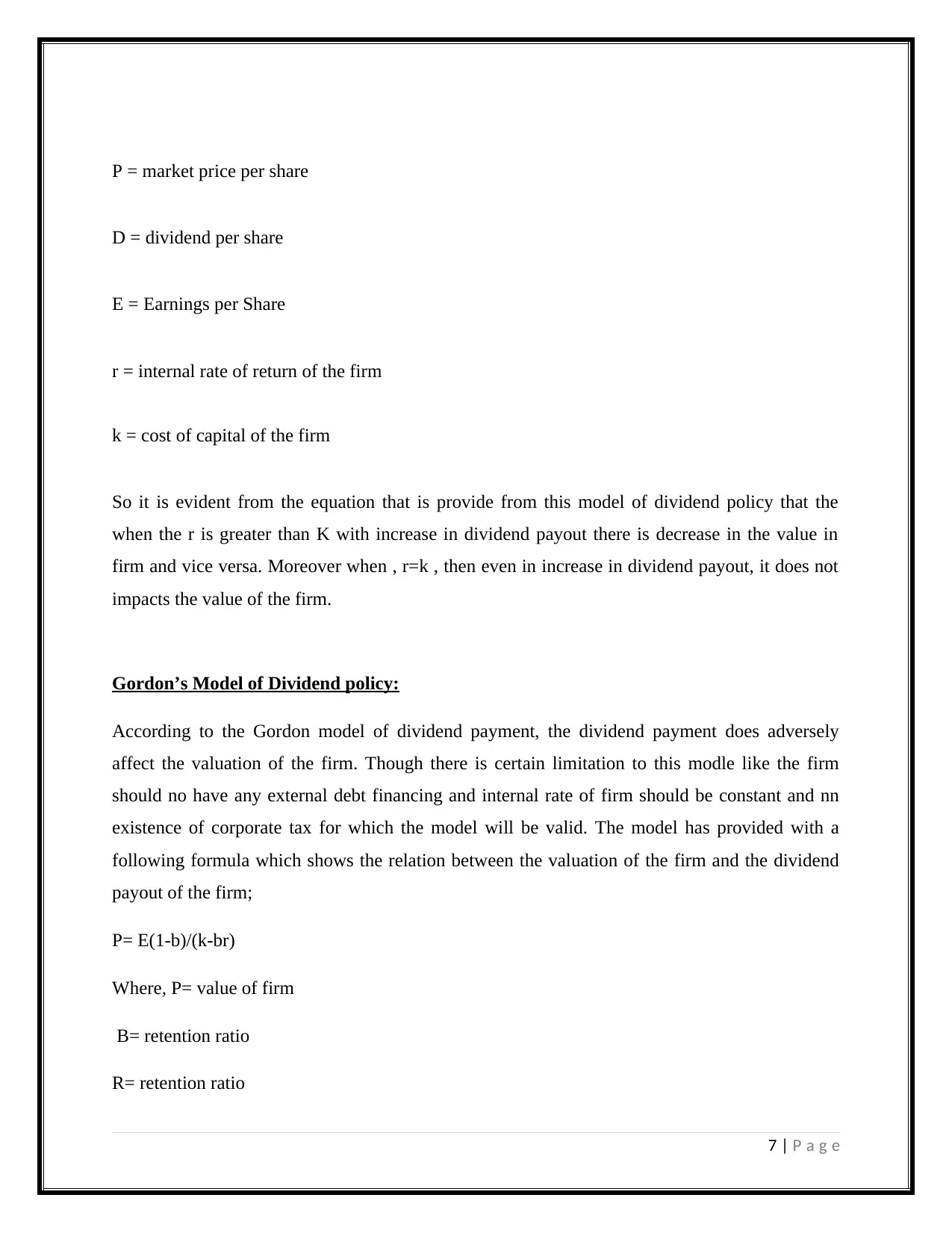
P = market price per share
D = dividend per share
E = Earnings per Share
r = internal rate of return of the firm
k = cost of capital of the firm
So it is evident from the equation that is provide from this model of dividend policy that the
when the r is greater than K with increase in dividend payout there is decrease in the value in
firm and vice versa. Moreover when , r=k , then even in increase in dividend payout, it does not
impacts the value of the firm.
Gordon’s Model of Dividend policy:
According to the Gordon model of dividend payment, the dividend payment does adversely
affect the valuation of the firm. Though there is certain limitation to this modle like the firm
should no have any external debt financing and internal rate of firm should be constant and nn
existence of corporate tax for which the model will be valid. The model has provided with a
following formula which shows the relation between the valuation of the firm and the dividend
payout of the firm;
P= E(1-b)/(k-br)
Where, P= value of firm
B= retention ratio
R= retention ratio
7 | P a g e
D = dividend per share
E = Earnings per Share
r = internal rate of return of the firm
k = cost of capital of the firm
So it is evident from the equation that is provide from this model of dividend policy that the
when the r is greater than K with increase in dividend payout there is decrease in the value in
firm and vice versa. Moreover when , r=k , then even in increase in dividend payout, it does not
impacts the value of the firm.
Gordon’s Model of Dividend policy:
According to the Gordon model of dividend payment, the dividend payment does adversely
affect the valuation of the firm. Though there is certain limitation to this modle like the firm
should no have any external debt financing and internal rate of firm should be constant and nn
existence of corporate tax for which the model will be valid. The model has provided with a
following formula which shows the relation between the valuation of the firm and the dividend
payout of the firm;
P= E(1-b)/(k-br)
Where, P= value of firm
B= retention ratio
R= retention ratio
7 | P a g e
Paraphrase This Document
Need a fresh take? Get an instant paraphrase of this document with our AI Paraphraser
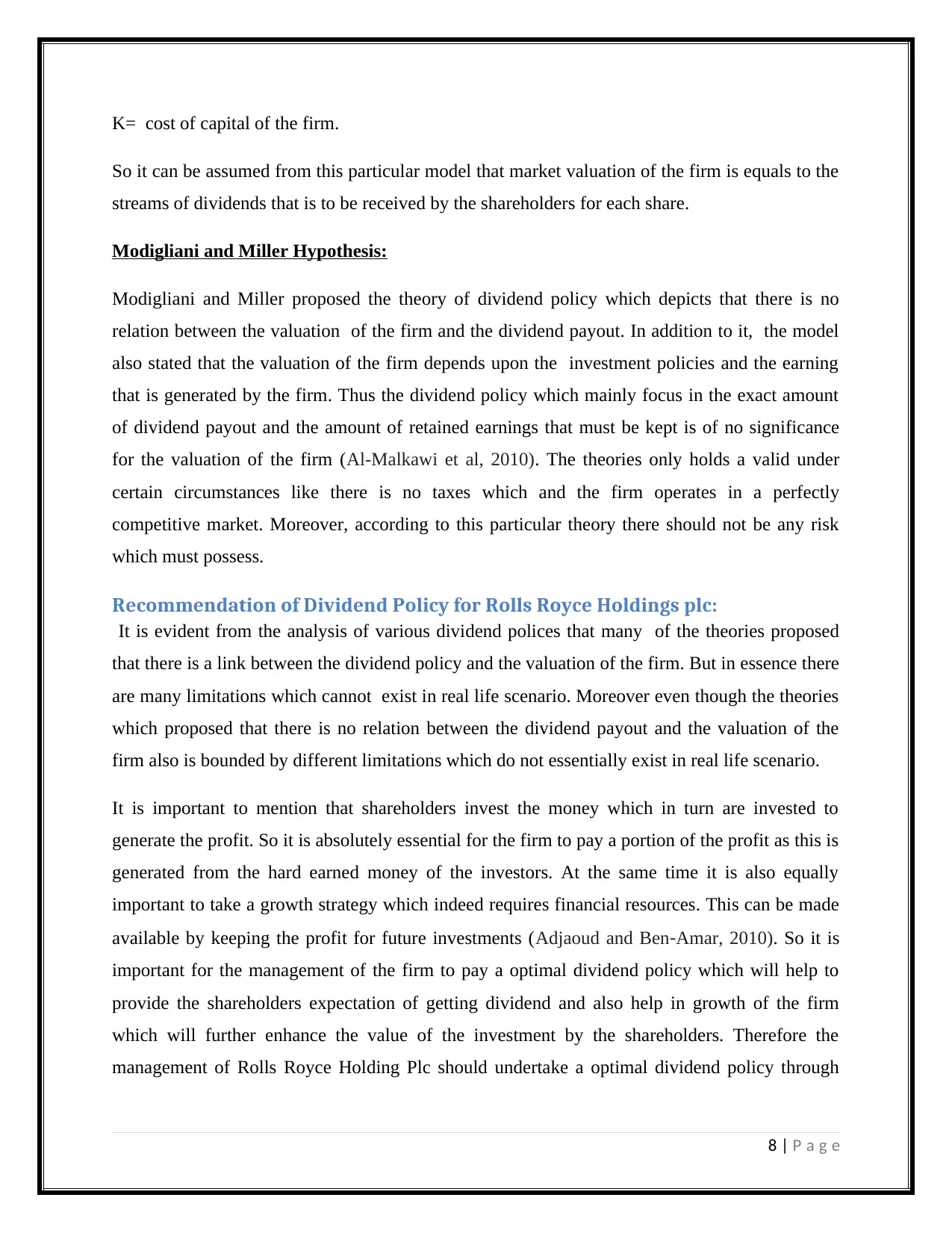
K= cost of capital of the firm.
So it can be assumed from this particular model that market valuation of the firm is equals to the
streams of dividends that is to be received by the shareholders for each share.
Modigliani and Miller Hypothesis:
Modigliani and Miller proposed the theory of dividend policy which depicts that there is no
relation between the valuation of the firm and the dividend payout. In addition to it, the model
also stated that the valuation of the firm depends upon the investment policies and the earning
that is generated by the firm. Thus the dividend policy which mainly focus in the exact amount
of dividend payout and the amount of retained earnings that must be kept is of no significance
for the valuation of the firm (Al-Malkawi et al, 2010). The theories only holds a valid under
certain circumstances like there is no taxes which and the firm operates in a perfectly
competitive market. Moreover, according to this particular theory there should not be any risk
which must possess.
Recommendation of Dividend Policy for Rolls Royce Holdings plc:
It is evident from the analysis of various dividend polices that many of the theories proposed
that there is a link between the dividend policy and the valuation of the firm. But in essence there
are many limitations which cannot exist in real life scenario. Moreover even though the theories
which proposed that there is no relation between the dividend payout and the valuation of the
firm also is bounded by different limitations which do not essentially exist in real life scenario.
It is important to mention that shareholders invest the money which in turn are invested to
generate the profit. So it is absolutely essential for the firm to pay a portion of the profit as this is
generated from the hard earned money of the investors. At the same time it is also equally
important to take a growth strategy which indeed requires financial resources. This can be made
available by keeping the profit for future investments (Adjaoud and Ben‐Amar, 2010). So it is
important for the management of the firm to pay a optimal dividend policy which will help to
provide the shareholders expectation of getting dividend and also help in growth of the firm
which will further enhance the value of the investment by the shareholders. Therefore the
management of Rolls Royce Holding Plc should undertake a optimal dividend policy through
8 | P a g e
So it can be assumed from this particular model that market valuation of the firm is equals to the
streams of dividends that is to be received by the shareholders for each share.
Modigliani and Miller Hypothesis:
Modigliani and Miller proposed the theory of dividend policy which depicts that there is no
relation between the valuation of the firm and the dividend payout. In addition to it, the model
also stated that the valuation of the firm depends upon the investment policies and the earning
that is generated by the firm. Thus the dividend policy which mainly focus in the exact amount
of dividend payout and the amount of retained earnings that must be kept is of no significance
for the valuation of the firm (Al-Malkawi et al, 2010). The theories only holds a valid under
certain circumstances like there is no taxes which and the firm operates in a perfectly
competitive market. Moreover, according to this particular theory there should not be any risk
which must possess.
Recommendation of Dividend Policy for Rolls Royce Holdings plc:
It is evident from the analysis of various dividend polices that many of the theories proposed
that there is a link between the dividend policy and the valuation of the firm. But in essence there
are many limitations which cannot exist in real life scenario. Moreover even though the theories
which proposed that there is no relation between the dividend payout and the valuation of the
firm also is bounded by different limitations which do not essentially exist in real life scenario.
It is important to mention that shareholders invest the money which in turn are invested to
generate the profit. So it is absolutely essential for the firm to pay a portion of the profit as this is
generated from the hard earned money of the investors. At the same time it is also equally
important to take a growth strategy which indeed requires financial resources. This can be made
available by keeping the profit for future investments (Adjaoud and Ben‐Amar, 2010). So it is
important for the management of the firm to pay a optimal dividend policy which will help to
provide the shareholders expectation of getting dividend and also help in growth of the firm
which will further enhance the value of the investment by the shareholders. Therefore the
management of Rolls Royce Holding Plc should undertake a optimal dividend policy through
8 | P a g e
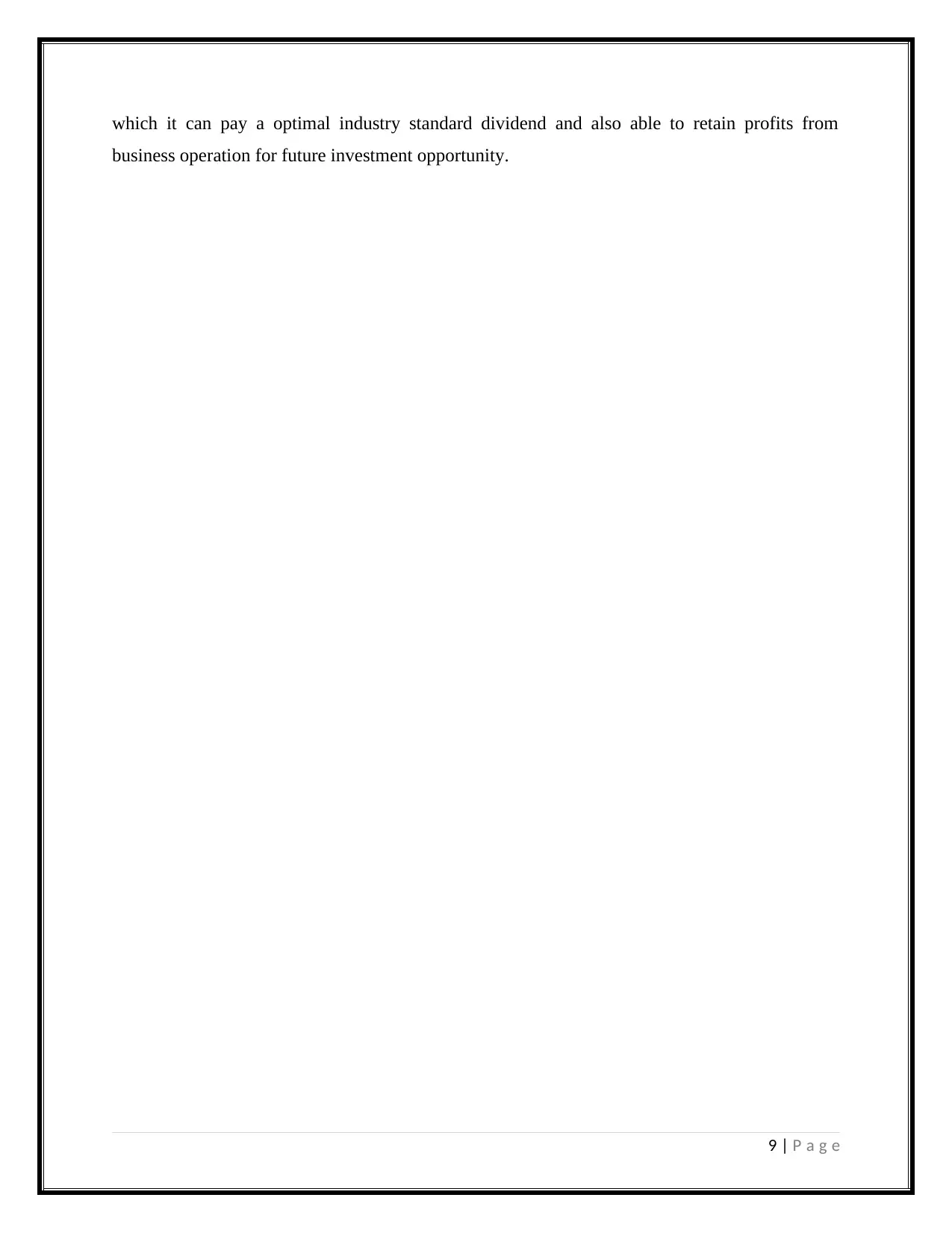
which it can pay a optimal industry standard dividend and also able to retain profits from
business operation for future investment opportunity.
9 | P a g e
business operation for future investment opportunity.
9 | P a g e
⊘ This is a preview!⊘
Do you want full access?
Subscribe today to unlock all pages.

Trusted by 1+ million students worldwide
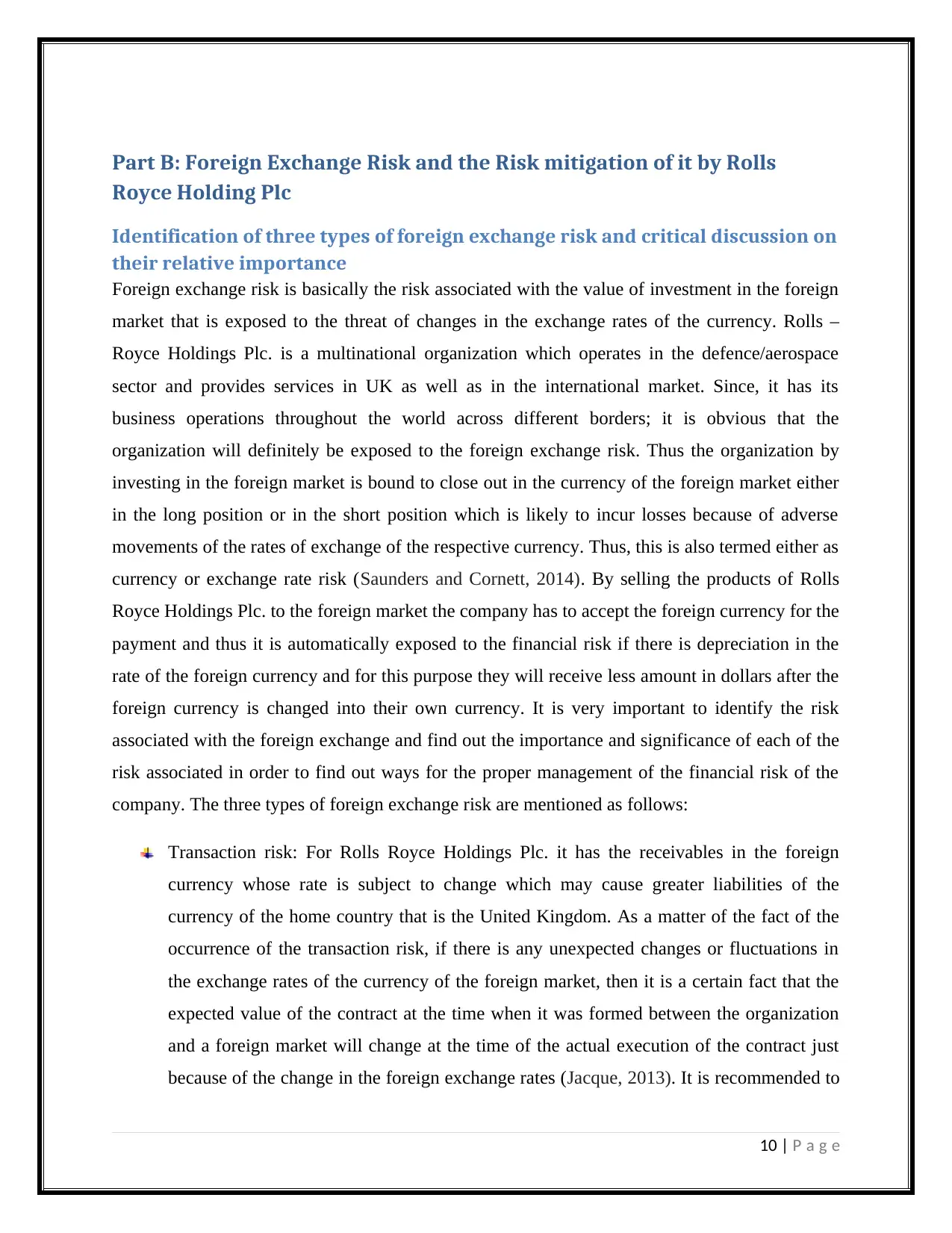
Part B: Foreign Exchange Risk and the Risk mitigation of it by Rolls
Royce Holding Plc
Identification of three types of foreign exchange risk and critical discussion on
their relative importance
Foreign exchange risk is basically the risk associated with the value of investment in the foreign
market that is exposed to the threat of changes in the exchange rates of the currency. Rolls –
Royce Holdings Plc. is a multinational organization which operates in the defence/aerospace
sector and provides services in UK as well as in the international market. Since, it has its
business operations throughout the world across different borders; it is obvious that the
organization will definitely be exposed to the foreign exchange risk. Thus the organization by
investing in the foreign market is bound to close out in the currency of the foreign market either
in the long position or in the short position which is likely to incur losses because of adverse
movements of the rates of exchange of the respective currency. Thus, this is also termed either as
currency or exchange rate risk (Saunders and Cornett, 2014). By selling the products of Rolls
Royce Holdings Plc. to the foreign market the company has to accept the foreign currency for the
payment and thus it is automatically exposed to the financial risk if there is depreciation in the
rate of the foreign currency and for this purpose they will receive less amount in dollars after the
foreign currency is changed into their own currency. It is very important to identify the risk
associated with the foreign exchange and find out the importance and significance of each of the
risk associated in order to find out ways for the proper management of the financial risk of the
company. The three types of foreign exchange risk are mentioned as follows:
Transaction risk: For Rolls Royce Holdings Plc. it has the receivables in the foreign
currency whose rate is subject to change which may cause greater liabilities of the
currency of the home country that is the United Kingdom. As a matter of the fact of the
occurrence of the transaction risk, if there is any unexpected changes or fluctuations in
the exchange rates of the currency of the foreign market, then it is a certain fact that the
expected value of the contract at the time when it was formed between the organization
and a foreign market will change at the time of the actual execution of the contract just
because of the change in the foreign exchange rates (Jacque, 2013). It is recommended to
10 | P a g e
Royce Holding Plc
Identification of three types of foreign exchange risk and critical discussion on
their relative importance
Foreign exchange risk is basically the risk associated with the value of investment in the foreign
market that is exposed to the threat of changes in the exchange rates of the currency. Rolls –
Royce Holdings Plc. is a multinational organization which operates in the defence/aerospace
sector and provides services in UK as well as in the international market. Since, it has its
business operations throughout the world across different borders; it is obvious that the
organization will definitely be exposed to the foreign exchange risk. Thus the organization by
investing in the foreign market is bound to close out in the currency of the foreign market either
in the long position or in the short position which is likely to incur losses because of adverse
movements of the rates of exchange of the respective currency. Thus, this is also termed either as
currency or exchange rate risk (Saunders and Cornett, 2014). By selling the products of Rolls
Royce Holdings Plc. to the foreign market the company has to accept the foreign currency for the
payment and thus it is automatically exposed to the financial risk if there is depreciation in the
rate of the foreign currency and for this purpose they will receive less amount in dollars after the
foreign currency is changed into their own currency. It is very important to identify the risk
associated with the foreign exchange and find out the importance and significance of each of the
risk associated in order to find out ways for the proper management of the financial risk of the
company. The three types of foreign exchange risk are mentioned as follows:
Transaction risk: For Rolls Royce Holdings Plc. it has the receivables in the foreign
currency whose rate is subject to change which may cause greater liabilities of the
currency of the home country that is the United Kingdom. As a matter of the fact of the
occurrence of the transaction risk, if there is any unexpected changes or fluctuations in
the exchange rates of the currency of the foreign market, then it is a certain fact that the
expected value of the contract at the time when it was formed between the organization
and a foreign market will change at the time of the actual execution of the contract just
because of the change in the foreign exchange rates (Jacque, 2013). It is recommended to
10 | P a g e
Paraphrase This Document
Need a fresh take? Get an instant paraphrase of this document with our AI Paraphraser
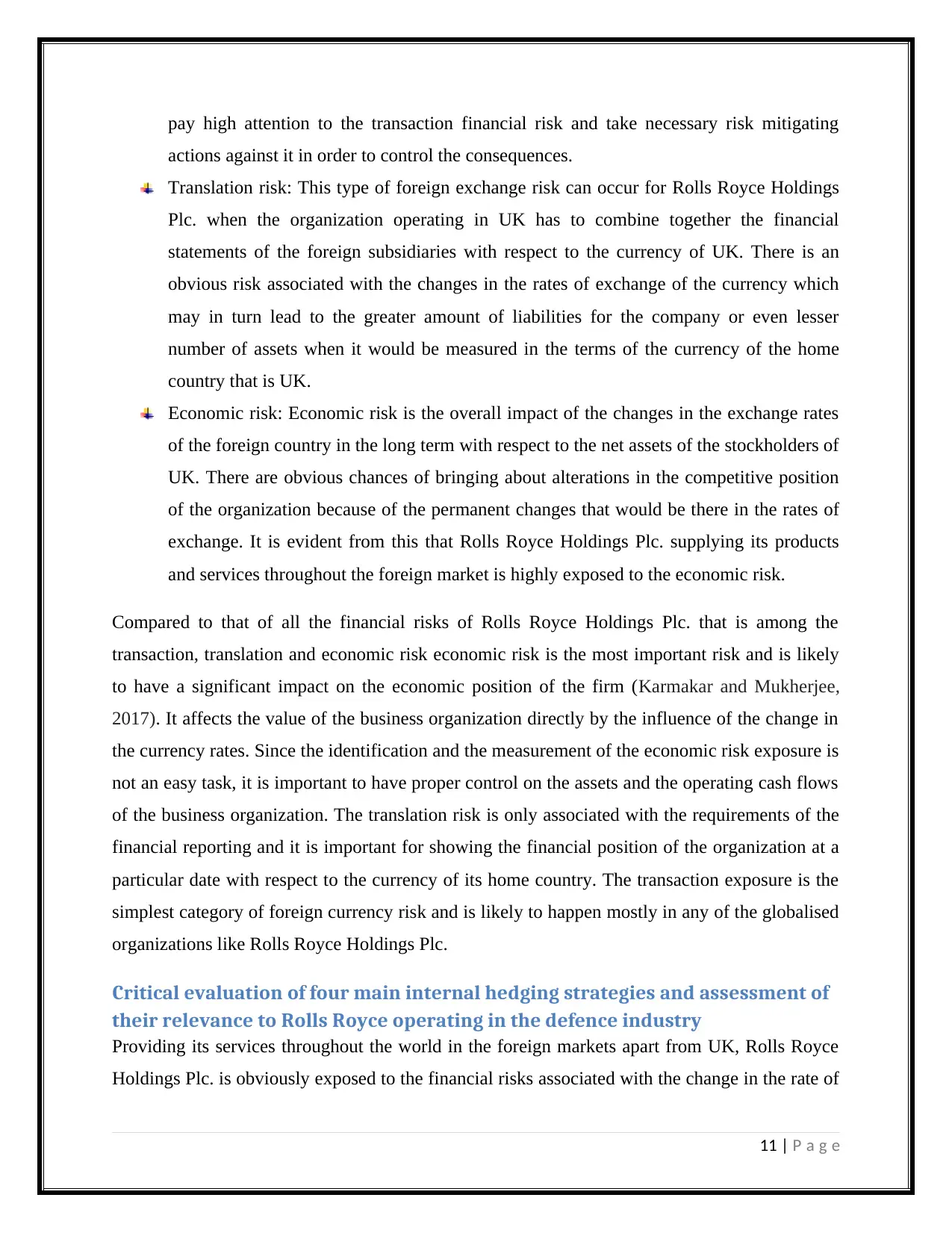
pay high attention to the transaction financial risk and take necessary risk mitigating
actions against it in order to control the consequences.
Translation risk: This type of foreign exchange risk can occur for Rolls Royce Holdings
Plc. when the organization operating in UK has to combine together the financial
statements of the foreign subsidiaries with respect to the currency of UK. There is an
obvious risk associated with the changes in the rates of exchange of the currency which
may in turn lead to the greater amount of liabilities for the company or even lesser
number of assets when it would be measured in the terms of the currency of the home
country that is UK.
Economic risk: Economic risk is the overall impact of the changes in the exchange rates
of the foreign country in the long term with respect to the net assets of the stockholders of
UK. There are obvious chances of bringing about alterations in the competitive position
of the organization because of the permanent changes that would be there in the rates of
exchange. It is evident from this that Rolls Royce Holdings Plc. supplying its products
and services throughout the foreign market is highly exposed to the economic risk.
Compared to that of all the financial risks of Rolls Royce Holdings Plc. that is among the
transaction, translation and economic risk economic risk is the most important risk and is likely
to have a significant impact on the economic position of the firm (Karmakar and Mukherjee,
2017). It affects the value of the business organization directly by the influence of the change in
the currency rates. Since the identification and the measurement of the economic risk exposure is
not an easy task, it is important to have proper control on the assets and the operating cash flows
of the business organization. The translation risk is only associated with the requirements of the
financial reporting and it is important for showing the financial position of the organization at a
particular date with respect to the currency of its home country. The transaction exposure is the
simplest category of foreign currency risk and is likely to happen mostly in any of the globalised
organizations like Rolls Royce Holdings Plc.
Critical evaluation of four main internal hedging strategies and assessment of
their relevance to Rolls Royce operating in the defence industry
Providing its services throughout the world in the foreign markets apart from UK, Rolls Royce
Holdings Plc. is obviously exposed to the financial risks associated with the change in the rate of
11 | P a g e
actions against it in order to control the consequences.
Translation risk: This type of foreign exchange risk can occur for Rolls Royce Holdings
Plc. when the organization operating in UK has to combine together the financial
statements of the foreign subsidiaries with respect to the currency of UK. There is an
obvious risk associated with the changes in the rates of exchange of the currency which
may in turn lead to the greater amount of liabilities for the company or even lesser
number of assets when it would be measured in the terms of the currency of the home
country that is UK.
Economic risk: Economic risk is the overall impact of the changes in the exchange rates
of the foreign country in the long term with respect to the net assets of the stockholders of
UK. There are obvious chances of bringing about alterations in the competitive position
of the organization because of the permanent changes that would be there in the rates of
exchange. It is evident from this that Rolls Royce Holdings Plc. supplying its products
and services throughout the foreign market is highly exposed to the economic risk.
Compared to that of all the financial risks of Rolls Royce Holdings Plc. that is among the
transaction, translation and economic risk economic risk is the most important risk and is likely
to have a significant impact on the economic position of the firm (Karmakar and Mukherjee,
2017). It affects the value of the business organization directly by the influence of the change in
the currency rates. Since the identification and the measurement of the economic risk exposure is
not an easy task, it is important to have proper control on the assets and the operating cash flows
of the business organization. The translation risk is only associated with the requirements of the
financial reporting and it is important for showing the financial position of the organization at a
particular date with respect to the currency of its home country. The transaction exposure is the
simplest category of foreign currency risk and is likely to happen mostly in any of the globalised
organizations like Rolls Royce Holdings Plc.
Critical evaluation of four main internal hedging strategies and assessment of
their relevance to Rolls Royce operating in the defence industry
Providing its services throughout the world in the foreign markets apart from UK, Rolls Royce
Holdings Plc. is obviously exposed to the financial risks associated with the change in the rate of
11 | P a g e
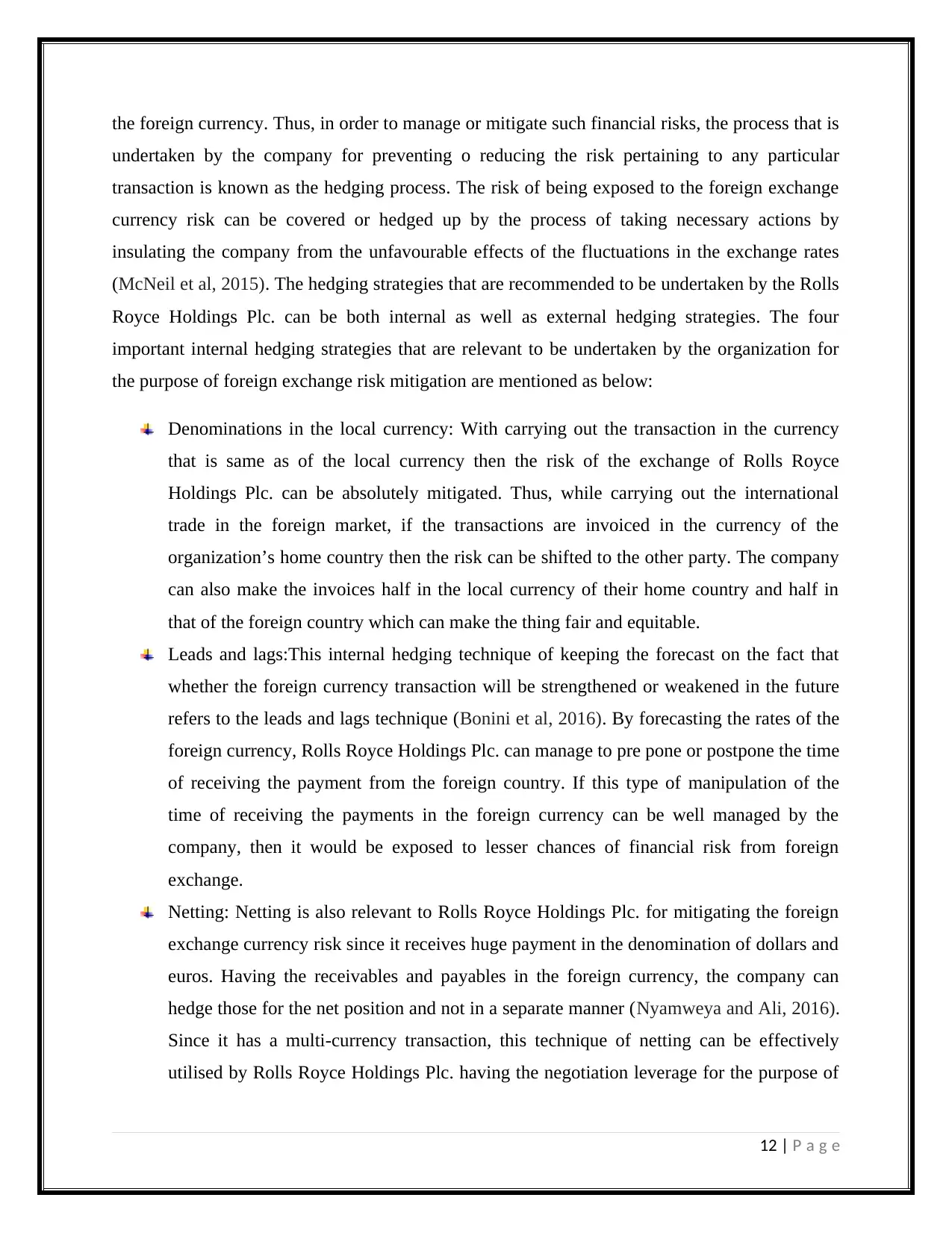
the foreign currency. Thus, in order to manage or mitigate such financial risks, the process that is
undertaken by the company for preventing o reducing the risk pertaining to any particular
transaction is known as the hedging process. The risk of being exposed to the foreign exchange
currency risk can be covered or hedged up by the process of taking necessary actions by
insulating the company from the unfavourable effects of the fluctuations in the exchange rates
(McNeil et al, 2015). The hedging strategies that are recommended to be undertaken by the Rolls
Royce Holdings Plc. can be both internal as well as external hedging strategies. The four
important internal hedging strategies that are relevant to be undertaken by the organization for
the purpose of foreign exchange risk mitigation are mentioned as below:
Denominations in the local currency: With carrying out the transaction in the currency
that is same as of the local currency then the risk of the exchange of Rolls Royce
Holdings Plc. can be absolutely mitigated. Thus, while carrying out the international
trade in the foreign market, if the transactions are invoiced in the currency of the
organization’s home country then the risk can be shifted to the other party. The company
can also make the invoices half in the local currency of their home country and half in
that of the foreign country which can make the thing fair and equitable.
Leads and lags:This internal hedging technique of keeping the forecast on the fact that
whether the foreign currency transaction will be strengthened or weakened in the future
refers to the leads and lags technique (Bonini et al, 2016). By forecasting the rates of the
foreign currency, Rolls Royce Holdings Plc. can manage to pre pone or postpone the time
of receiving the payment from the foreign country. If this type of manipulation of the
time of receiving the payments in the foreign currency can be well managed by the
company, then it would be exposed to lesser chances of financial risk from foreign
exchange.
Netting: Netting is also relevant to Rolls Royce Holdings Plc. for mitigating the foreign
exchange currency risk since it receives huge payment in the denomination of dollars and
euros. Having the receivables and payables in the foreign currency, the company can
hedge those for the net position and not in a separate manner (Nyamweya and Ali, 2016).
Since it has a multi-currency transaction, this technique of netting can be effectively
utilised by Rolls Royce Holdings Plc. having the negotiation leverage for the purpose of
12 | P a g e
undertaken by the company for preventing o reducing the risk pertaining to any particular
transaction is known as the hedging process. The risk of being exposed to the foreign exchange
currency risk can be covered or hedged up by the process of taking necessary actions by
insulating the company from the unfavourable effects of the fluctuations in the exchange rates
(McNeil et al, 2015). The hedging strategies that are recommended to be undertaken by the Rolls
Royce Holdings Plc. can be both internal as well as external hedging strategies. The four
important internal hedging strategies that are relevant to be undertaken by the organization for
the purpose of foreign exchange risk mitigation are mentioned as below:
Denominations in the local currency: With carrying out the transaction in the currency
that is same as of the local currency then the risk of the exchange of Rolls Royce
Holdings Plc. can be absolutely mitigated. Thus, while carrying out the international
trade in the foreign market, if the transactions are invoiced in the currency of the
organization’s home country then the risk can be shifted to the other party. The company
can also make the invoices half in the local currency of their home country and half in
that of the foreign country which can make the thing fair and equitable.
Leads and lags:This internal hedging technique of keeping the forecast on the fact that
whether the foreign currency transaction will be strengthened or weakened in the future
refers to the leads and lags technique (Bonini et al, 2016). By forecasting the rates of the
foreign currency, Rolls Royce Holdings Plc. can manage to pre pone or postpone the time
of receiving the payment from the foreign country. If this type of manipulation of the
time of receiving the payments in the foreign currency can be well managed by the
company, then it would be exposed to lesser chances of financial risk from foreign
exchange.
Netting: Netting is also relevant to Rolls Royce Holdings Plc. for mitigating the foreign
exchange currency risk since it receives huge payment in the denomination of dollars and
euros. Having the receivables and payables in the foreign currency, the company can
hedge those for the net position and not in a separate manner (Nyamweya and Ali, 2016).
Since it has a multi-currency transaction, this technique of netting can be effectively
utilised by Rolls Royce Holdings Plc. having the negotiation leverage for the purpose of
12 | P a g e
⊘ This is a preview!⊘
Do you want full access?
Subscribe today to unlock all pages.

Trusted by 1+ million students worldwide
1 out of 17
Related Documents
Your All-in-One AI-Powered Toolkit for Academic Success.
+13062052269
info@desklib.com
Available 24*7 on WhatsApp / Email
![[object Object]](/_next/static/media/star-bottom.7253800d.svg)
Unlock your academic potential
Copyright © 2020–2025 A2Z Services. All Rights Reserved. Developed and managed by ZUCOL.




